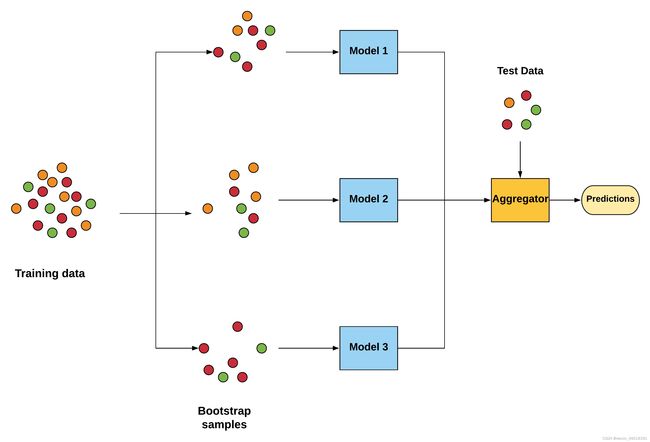从jieba分词到BERT-wwm——中文自然语言处理(NLP)基础分享系列(6)
第一个机器学习模型
上一回我们得到新闻标题文档的压缩到64维的LSI向量表示,我们用它来训练一个机器学习(Machine Learning)模型。
首先我们运行代码,重新在内存中加载它。
import pandas as pd
import pickle
from sklearn.feature_extraction.text import TfidfVectorizer
pkl_file_rb = open(r'./save_file', 'rb')
train =pickle.load(pkl_file_rb)
corpus = pd.concat([train . title1_tokenized, train . title2_tokenized])
corpus = [c for c in corpus]
tfidf_model = TfidfVectorizer().fit(corpus)
matrix1= tfidf_model.transform(train['title1_tokenized'])
matrix2= tfidf_model.transform(train['title2_tokenized'])
from sklearn.decomposition import TruncatedSVD
svd_model = TruncatedSVD(n_components=64, algorithm='randomized', n_iter=100, random_state=122) #参数n_components即降维的目标维数r
svd_model.fit(tfidf_model.transform(corpus))
matrix1_sub = svd_model.transform(matrix1)
matrix2_sub = svd_model.transform(matrix2)
我们把来自新闻标题A和B的LSI向量做一个差值,然后进行归一化处理。
from sklearn import preprocessing
input_data = matrix1_sub - matrix2_sub
input_data = preprocessing.scale(input_data)
input_data.shape
(320552, 64)
将目标变量做数字化处理
我们已经将所有的新闻标题A和B以数字化表示,做成64维输入变量。
接下来需要将分类列 label 进行从文本到数字的转换。我们同样需要一个字典将分类的文字转换成索引。
# 定义每一个分类对应到的索引数字
label_to_index = { 'unrelated' : 0 , 'agreed' : 1 , 'disagreed' : 2 }
# 将分类标签对应到刚定义的数字
y_train_ = train . label . apply ( lambda x : label_to_index [ x ])
# y_train_ = np . asarray ( y_train_ ). astype ( 'float32' )
print('y_train_.shape: ',y_train_.shape)
y_train_ [11: 16 ]
y_train_.shape: (320552,)
id
10 1
13 1
12 1
15 0
17 2
Name: label, dtype: int64
切割训练数据集& 验证数据集
我们需要将整个训练数据集(Training Set)的多少比例切出来当作验证数据集(Validation Set)。此例中我们用10 %。
但为何要再把本来的训练数据集切成2 个部分呢?
一般来说,我们在训练时只会让模型看到训练数据集,并用模型没看过的验证数据集来测试该模型在真实世界的表现。(毕竟我们没有测试数据集的答案)

要切训练数据集/ 验证数据集,scikit-learn 中的 train_test_split 函数是一个不错的选择:
from sklearn import model_selection
x_train, x_val, y_train, y_val = model_selection.train_test_split(input_data, y_train_, test_size = 0.1, random_state = 911) # 取10%做验证集
print("Train Shape: {}".format(x_train.shape))
print("valid Shape: {}".format(x_val.shape))
Train Shape: (288496, 64)
valid Shape: (32056, 64)
训练机器学习模型
集成学习(ensemble learning),并不是一个单独的机器学习算法,而是通过构建并结合多个机器学习器(基学习器,Base learner)来完成学习任务。
对于训练集数据,我们通过训练若干个个体弱学习器(weak learner),通过一定的结合策略,就可以最终形成一个强学习器(strong learner),以达到博采众长的目的。
我们首先将建立一个随机森林模型,这是一个称为Bagging类型的集成类型算法。这个模型由几个“树”组成(我们将构造100棵树!)这将独立考虑每对新闻标题的LSI向量数据,可以并行运行。然后,随机森林模型做出一个民主决策,投票决定属于哪种分类关系。

我们使用 scikit-learn 中的 RandomForestClassifier 函数实现随机森林模型。
之后我们再建立一个梯度提升树模型,它属于所谓Boosting系列算法。多个学习器是依次构建的,个体学习器之间存在强依赖关系,需要串行生成。
我们使用 scikit-learn 中的 GradientBoostingClassifier 函数实现梯度提升树模型。
# Random Forest Classifier
from sklearn.ensemble import RandomForestClassifier
rfc = RandomForestClassifier(n_estimators=100, max_depth=5, random_state=1)
rfc.fit(x_train, y_train)
predictions = rfc.predict(x_val)
predictions
array([0, 0, 1, ..., 0, 0, 0], dtype=int64)
我们可以直接调用 scikit-learn 中的 accuracy_score 函数计算这个随机森林模型在验证集上的准确率。
from sklearn.metrics import accuracy_score
# acc_rfc = round(accuracy_score(predictions, np.eye(3)[y_val]) * 100, 2)
acc_rfc = round(accuracy_score(predictions, y_val) * 100, 2)
print('Accurency of RandomForestClassifier: {:.1f}%'.format(acc_rfc))
Accurency of RandomForestClassifier: 71.5%
# Gradient Boosting Classifier
from sklearn.ensemble import GradientBoostingClassifier
gbk = GradientBoostingClassifier()
gbk.fit(x_train, y_train)
y_pred = gbk.predict(x_val)
acc_gbk = round(accuracy_score(y_pred, y_val) * 100, 2)
print('Accurency of GradientBoostingClassifier: {:.1f}%'.format(acc_gbk))
Accurency of GradientBoostingClassifier: 73.0%
效果比较好的是梯度提升树模型,准确率的结果是73.0%,与通过简单的LSI向量余弦距离方法仅有很微弱的提升,这可能是LSI数据供给的能力上限了。
之后,我们将从一个全新的视角来处理文档的数字化表示,力求保留下更完整的数据信息供模型所用。
好了,就到这儿吧。
本系列共12期,将分6天发布。相关代码已全部分享在我的github项目(moronism189/chinese-nlp-stepbystep)下,急的可以先去那里下载。
